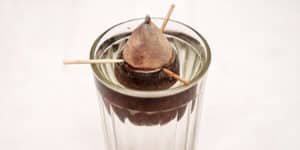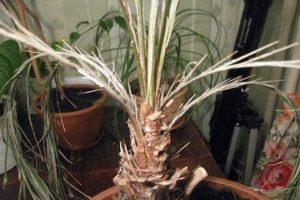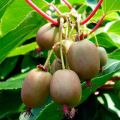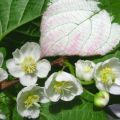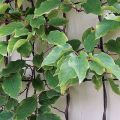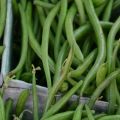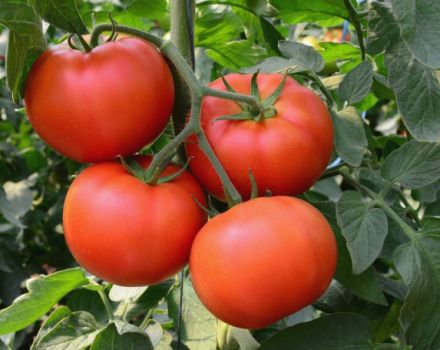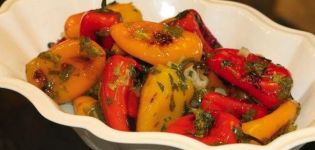Description and varieties of actinidia varieties Arguta, planting and care
Actinidia of the Arguta variety is rarely grown on the plots of gardeners from the CIS countries. The plant bears delicious fruits rich in vitamins. Actinidia does not require painstaking care, it takes root well. The variety is resistant to frost, brings a bountiful harvest. For a safe planting culture, you should familiarize yourself with all the features.
Description
According to the description, the Argut actinidia is a perennial deciduous vine, which is usually used to decorate the garden. A fruiting plant, it came to the countries of the former USSR from China and Japan. In Russia, it is usually grown in the Far East, Sakhalin and the Kuriles, sometimes in the Moscow region. The life span of a culture is about 75-90 years.
The stem grows up to 30 meters in length. It is thin, 20 cm in diameter. As it grows older, its base becomes lignified, acquires a brownish-gray color instead of olive color. The stem is twisted, during cultivation it should be provided with an arch or other support.
The foliage of actinidia looks elegant throughout its life. Before pollen begins, it is painted in bright green, after which it brightens to a salad shade. In autumn, the plant changes its tone from rich lemon to crimson-raspberry, crimson. The leaf plate has an elliptical shape, the ends are sharply pointed.
The leaf is 8-12 cm long, 3-5 cm wide, the edges are carved with small teeth. They bloom in March and fall in mid-October. Actinidia belongs to the group of dioecious plants. You can get a regular harvest only when planting male and female shrubs on the site at the same time in a ratio of 1: 5. The former act as pollinators, while the others bear fruit. In the absence of a pollinator, the berries become smaller, and the amount of harvest decreases.
Flowering and fruiting of actinidia
Liana blooms after June 15. The flowers emanate a stunning, sweet scent. Inflorescences with a diameter of 2 cm, white. Fruiting in the 5th year of life in the second half of September.
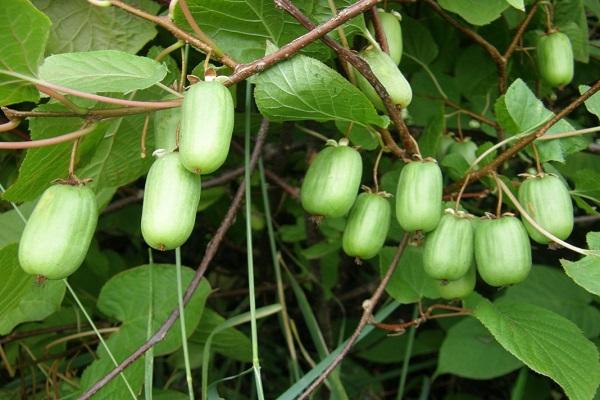
Varieties of varieties
Actinidia Argut has more than 10 varieties. They differ in fruit, appearance, gender. It's easy to grow varieties, even a novice gardener can cope with this task.
Balsamic
A late-ripening Russian variety, the fruits ripen by the end of September. They resemble a parallelepiped in shape, with rounded tops.Fruits with a tart odor, like pine needles, tender flesh and smooth, green skin.
Lunar
This is a novelty, developed specifically for the middle zone of the Russian Federation. The berries grow olive green, sweetish, refreshing. They are slightly flattened at the sides.

September
An incredibly hardy vine variety that can withstand frosts down to -40. The fruits are tasty, tender, sweet, with an emerald skin. The plant grows up to 7 meters high, grows about 1.5-2 meters per season. Periodic pruning is required. The life span is about 30 years.
Primorskaya
The variety is famous for its large berries with the smell of apples, sweet and sour taste. The fruits are covered with shiny, green-yellow skin with small tubercles. The variety is not afraid of diseases, harmful insects, but the presence of male plants is required. There will be a lot of harvest if you put a bee hive next to it.
Geneva
The variety is distinguished by its pinkish-purple fruits, the most delicious of all varieties. They taste like honey and are widely used to make wine. The variety loves areas well lit by the sun, does not tolerate drafts. Liana bears fruit constantly.
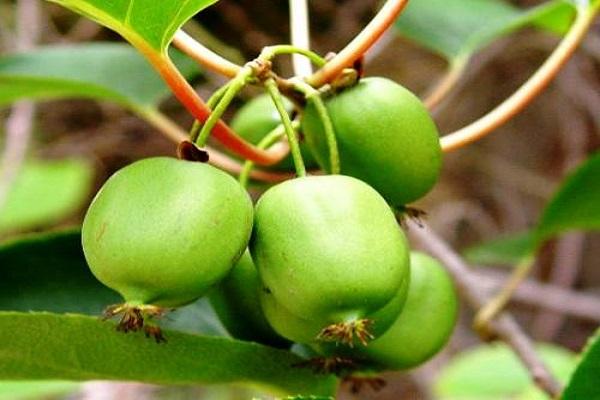
Green balm
The taste of this variety is balsamic, sweet and sour. About 3 kilograms of berries ripen from one bush. The species loves sunny places and partial shade, but winter-hardy, survives frosts. Pest and disease attacks are rare.
Weiki
Fruits of sweet taste with sourness, salad color. In places where sunlight enters, reddish specks form. The variety is great for decorating a plot. Up to 10 kg of berries can be harvested from one bush. The shrub grows strongly, needs careful pruning, plucking of branches.
Issei (or Issai)
The variety is self-fertile, but it is better to plant female and male vines next to each other. The first harvest ripens after 2 years of the life of the shrub. The species loves sunny places without strong winds. Actinidia Issey must be regularly plucked, cut off, the bush is prone to overgrowth.
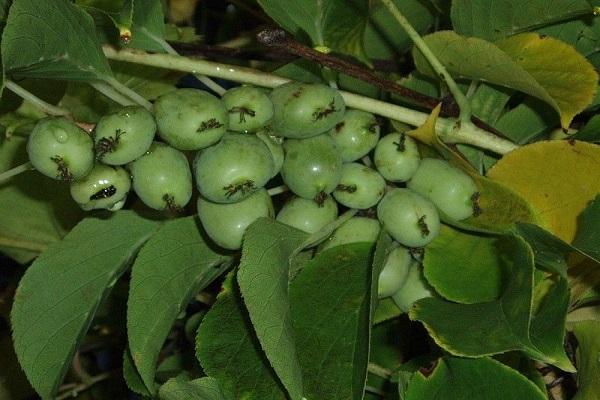
Golden braid
The variety is a powerful liana, 30 meters long. It has dark, large leaves. The variety survives frosts down to -40 degrees. Berries are greenish-yellow, ellipse-shaped, sweet taste. The subspecies blooms in the last days of June.
Jumbo
The variety gives large fruits, ripens by the end of October. The weight of one berry is about 20 grams. The first crop is harvested 5 years after planting. The variety is famous for its short pollen period, about a week. The crop is well transported and good.
Kokuwa
The fruits of the Kokuwa variety are similar to small kiwis, they are eaten with a juicy skin, lying, sweet taste with lemon sourness. The variety is self-fertile, but it is better to plant male and female vines next to it. Low frost resistance, the plant can withstand cold temperatures down to -22 degrees.
Relay race
Actinidia Relay is famous for its sweet and sour fruits, weighing up to 17 grams. The plant gives off an apple-pineapple smell. This is one of the largest varieties.
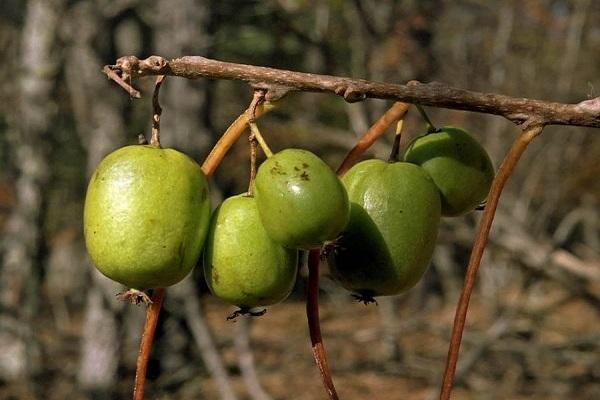
Taiga emerald
The variety is distinguished by three valuable features - high resistance to cold, high content of ascorbic acid over 100 mg /% and large fruit weight. It amounts to 8.9 and 18.1 grams.
Pineapple
Pineapple actinidia is a variety of domestic selection, it has oval fruits ripening in October with a sweet and sour taste. The variety got its name due to the fruity smell that spreads around when the thin skin is cut. The variety is frost-resistant, does not require special care, but needs constant pruning. In the heat, the plant must be constantly watered.
Viti Kiwi
Actinidia subspecies Viti Kiwi produces many fruits, resistant to cold. It is often grown for industrial purposes. Fruits are juicy, outwardly like small, elongated green apples. In the context, they can be mistaken for kiwi, only pitted.The variety does not tolerate windy places, where there is little light, acidification of the earth. The soil must be drained. The plant should be planted on a hill so that there is no accumulation of groundwater. There are no seeds in the berries.
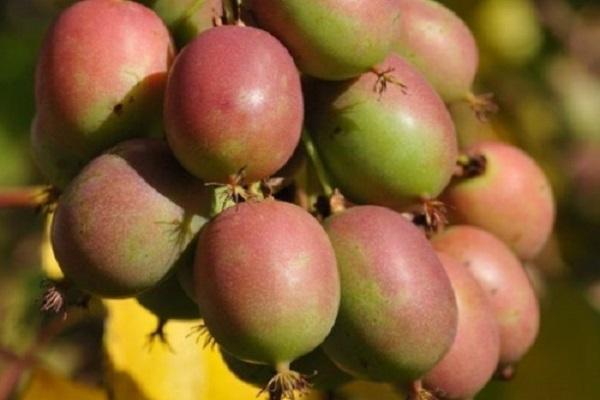
Giraldi
Liana varieties Giraldi freezes at a temperature of -30, this is the most thermophilic culture. Outwardly, the appearance resembles the Argut actinidia, it differs only in the thickness of the leaves, pubescence. The yield is good, up to 5 kg of fruit per bush.
Kens Red
Actinidia Kens Red produces sweet and sour fruits and is famous for its decorative foliage. The fruit looks like a miniature kiwi with a slight blush. The plant is powerful, tall, reaches 7 meters in height, lives up to 90 years. 5 years after planting, yields a harvest of large berries.
The variety tolerates low temperatures and adverse weather conditions well.
Purple garden
A variety of actinidia Purple Sadovaya differs from its counterparts in fruit color. They are purple in color and eaten with the skin. It is thin, slightly sour. The pulp is purple-red. Fruits grow large, up to 4 cm long. The first harvest will ripen 3 years after planting. The variety is propagated by layering, seeds, cuttings.
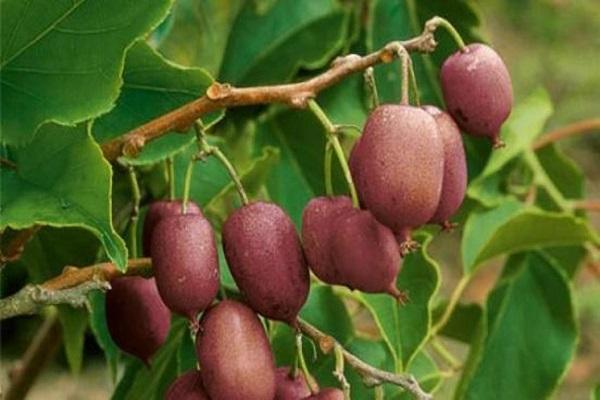
Bayern
The variety is an achievement of German breeding. Liana gives a bountiful harvest, bears fruit in the last days of September from the 3rd year of life. One bush gives up to 10 kg of fruit. They are green, with a little blush, oval-shaped 3 * 2.5 cm. The variety tolerates frosts down to -30 degrees, and needs piece supports when grown.
Each of the subspecies has its own nuances in the selection of a place, the formation of a shrub, and reproduction.
Growing features
Actinidia grows well on loose, loamy, fertile soils. They should be well-drained with a lot of humus, slightly acidic and neutral ground solution. The plant does not tolerate stagnation of water in the soil, reacts poorly to dry oxygen and lack of moisture. Actinidia Argut is grown in the same way as other vines. There are no particular nuances in planting and leaving.

Preparation of planting material
Experienced gardeners recommend buying seedlings with a grafted root system. It is better to take material in a nursery or on the market from trusted sellers. Do not leave them with bare roots in the heat or wind. Planting material should be purchased 3 years of age or more. These should be male and female seedlings, in a ratio of 1-2: 5. The sex of the creeper is determined by the structure of the flowers in the first bloom. The male plant has buds with a mass of stamens, but without a pistil. Female actinidia have multiple pistils.
Timing and site preparation
Planting should be carried out in March or October. Liana loves a lot of sunny color, this contributes to a large number of crops and a long life. Actinidia should be planted in a sunny place, which is in partial shade after lunch. The site should be located on a slope or hill, where the liquid does not stagnate in the rhizome, but flows down.
Dig holes 2 weeks before planting. Their size should be 60 * 70 cm. Between seedlings maintain a distance of 2 meters.
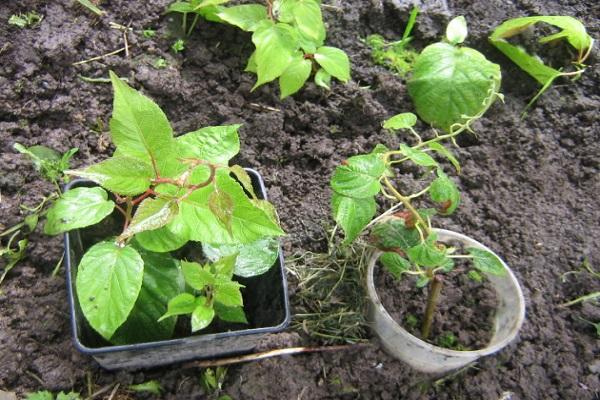
Planting process
The technology of planting actinidia consists of the following stages:
- on the bottom of the prepared hole, pour a drainage layer of 15-20 cm using gravel, expanded clay or pebbles;
- check the soil for acidity, if necessary, fertilize with wood ash, superphosphate and potassium;
- pour a mound at the bottom of the hole, install a seedling on it, having previously straightened the root system;
- fill the hole, the root collar should remain at ground level;
- Water and mulch abundantly, as young bushes are afraid of the sun.
Spruce branches and dry leaves are used as a mulching material. The root system is the "weak point" of actinidia. It can be opened when transplanting only at the time of installation in a pit.
Care advice
Actinidia is easy to care for. It is necessary to water it in a timely manner, fertilize it, loosen the soil, cut it off. The last aspect is the most important. Actinidia Argut is prone to overgrowth. If the care is competent and comprehensive, the plant will thank you with a bountiful harvest.
Watering
Actinidia should be irrigated abundantly during dry periods, 2-3 times a week. Defend the water beforehand. When the weather is rainy, watering is reduced to 1 time per week.
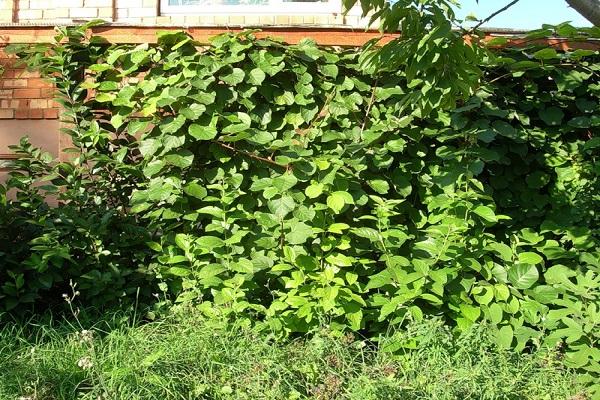
Pruning
Pruning actinidia leads to stimulation of stem growth, awakening of the kidneys. The procedure is carried out with plants 3-4 years old. Prune it during the summer by excising damaged, dry branches. By winter, pluck the tips of the shoots, this will slow down their growth. Rejuvenating pruning involves removing old branches from 10-year-old plants.
You can not shorten the vine in March and September, since it has a strong sap flow.
Trellis
Actinidia needs constant support. It can be a wall, structure, or a special trellis. The design helps to shape the plant into an arch. When growing vines on a building, you will have to collect fruits on the roof.
Top dressing
Fertilize actinidia with mineral dressings. This will increase her growth and increase her yield. In March, add 20 g of potassium and phosphorus, 35 g of nitrogen per 1 square meter of land. After, water the plant abundantly. Repeat the procedure at the end of fruiting and before winter.
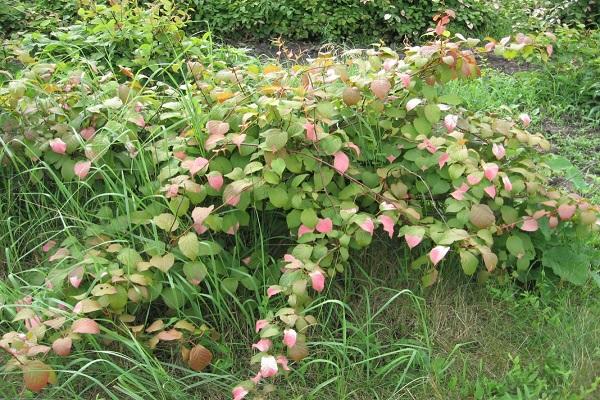
Pest and disease control
Actinidia is resistant to diseases and harmful insects, but it is better to carry out prevention in the form of regular maintenance. The leaves are protected from fungal infections by pruning dry branches and fruits. To avoid the attack of harmful insects, every spring, treat the liana with Bordeaux liquid, a solution of soda ash 0.5%.
Reproduction of actinidia
The plant is bred with seeds, root shoots, layering. Reproduction by cuttings is considered the most reliable method.
Role in landscape design
Liana is widely used to decorate gates, arches, and the building itself. The plant is in perfect harmony with any flowers, crops. Noble green shade will delight the eye and create a cozy atmosphere.
